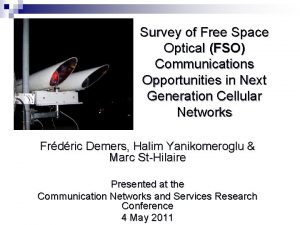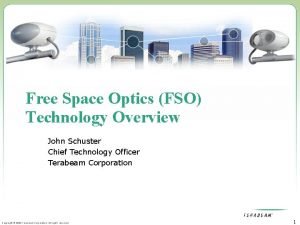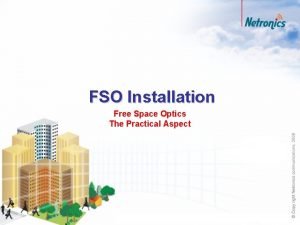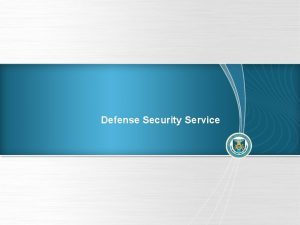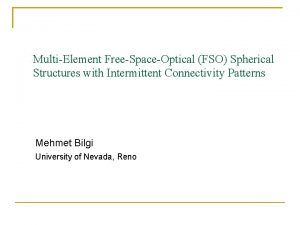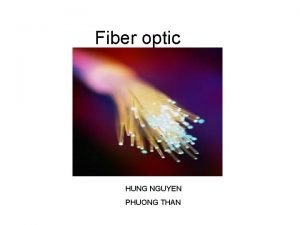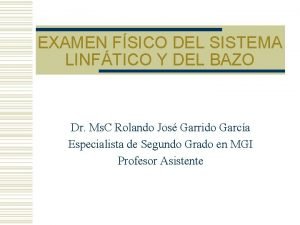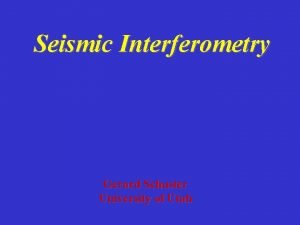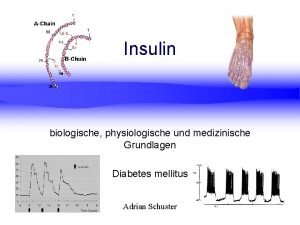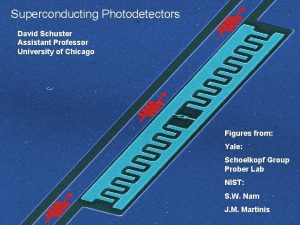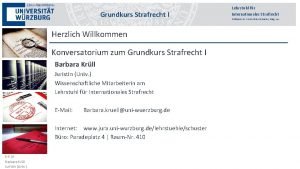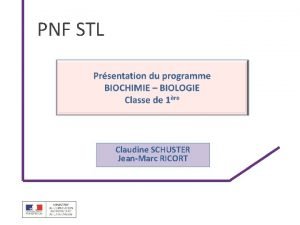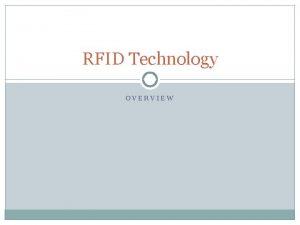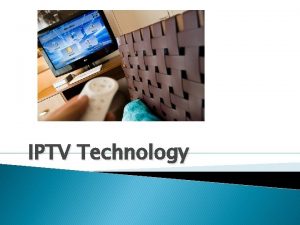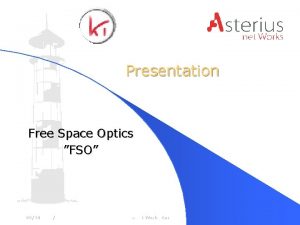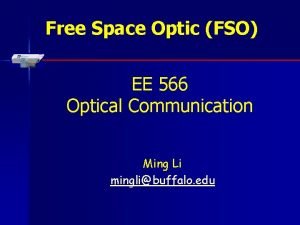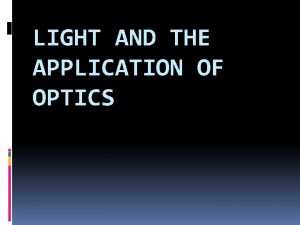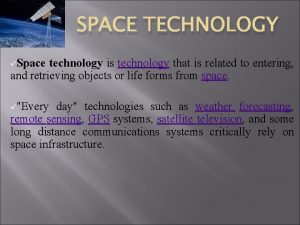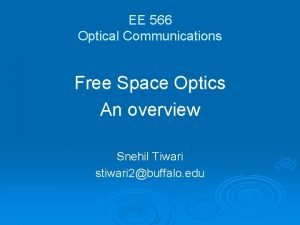Free Space Optics FSO Technology Overview John Schuster



















- Slides: 19

Free Space Optics (FSO) Technology Overview John Schuster Chief Technology Officer Terabeam Corporation Copyright © 2002 Terabeam Corporation. All rights reserved. 1

Presentation Overview • Why Free Space Optics? • Challenges • Transceiver Design • Predicting Availability • Eye Safety • Applications & Network Integration • The Future of FSO Copyright © 2002 Terabeam Corporation. All rights reserved. 2

Why Free Space Optics (FSO)? The “Last Mile” Bottleneck Problem Wide Area Networks between major cities are extremely fast • Fiber based • >2. 5 Gbps Local Area Networks in buildings are also fast • >100 Mbps The connections in between are typically a lot slower • 0. 3 -1. 5 Mbps Only about 5% of commercial buildings are lit with fiber Copyright © 2002 Terabeam Corporation. All rights reserved. 3

Why Free Space Optics? Why Not Just Bury More Fiber? • Cost • Rights of Way • Permits • Trenching • Time With FSO, especially through the window, no permits, no digging, no fees Copyright © 2002 Terabeam Corporation. All rights reserved. 4

Why Free Space Optics? How Fiber Optic Cable Works Glass Fiber Strands Light Source Detector Light Source Network Device • Pulses of light communicate the data • “ON” = 1 • “OFF = 0 • Capable of more than 40 Gbps • >7 CDs a second Copyright © 2002 Terabeam Corporation. All rights reserved. 5

Why Free Space Optics? How FSO Works 2 Transmitter projects the carefully aimed light pulses into the air 3 A receiver at the other end of the link collects the light using lenses and/or mirrors 5 Reverse direction data transported the same way. • Full duplex 1 Network traffic converted into pulses of invisible light representing 1’s and 0’s 4 Received signal converted back into fiber or copper and connected to the network Anything that can be done in fiber can be done with FSO Copyright © 2002 Terabeam Corporation. All rights reserved. 6

Why Free Space Optics? Very Narrow and Directional Beams • • • Beams only a few meters in diameter at a kilometer Allows VERY close spacing of links without interference No side lobes Highly secure Efficient use of energy Ranges of 20 m to more than 8 km possible Copyright © 2002 Terabeam Corporation. All rights reserved. 7

Why Free Space Optics? Deployment Behind Windows • Rapid installations without trenching and permitting • Direct connection to the end user • Bypasses the building owner – No roof rights – No riser rights Copyright © 2002 Terabeam Corporation. All rights reserved. 8

Why Free Space Optics? The FSO “Value Proposition” • No interference • Unlicensed • Easy to install • Through the window (or from the rooftop) • No trenching, no permits • Fiber-like data rates • Many deployment options • Fungible equipment Copyright © 2002 Terabeam Corporation. All rights reserved. 9

Fundamental Concepts Small Angles - Divergence & Spot Size 1° ≈ 17 mrad → 1 mrad ≈ 0. 0573° Small angle approximation: Angle (in milliradians) * Range (km)= Spot Size (m) 1 m 1 mrad 1 km Divergence Range Spot Diameter 0. 5 mrad 1. 0 km ~0. 5 m (~20 in) 2. 0 mrad 1. 0 km ~2. 0 m (~6. 5 ft) 4. 0 mrad (~ ¼ deg) 1. 0 km ~4. 0 m (~13. 0 ft) Copyright © 2002 Terabeam Corporation. All rights reserved. 10

Fundamental Concepts The Decibel - d. B • A logarithmic ratio between two values • In the optical world of Power in m. W, d. B=10*Log(power 2/power 1) • 3 d. B = ratio of 2/1 Gain/Loss Multiplier +30 db 1000 +20 db 100 +10 db 10 0 db 1 • 6 d. B = ratio of 4/1 -10 db . 1 • 10 d. B = ratio of 10/1 -20 db . 01 -30 db . 001 • 20 d. B = ratio of 100/1 • 50 d. B= ratio of 100, 000/1 Copyright © 2002 Terabeam Corporation. All rights reserved. 11

Challenges Sunlight Environmental factors Window Attenuation Fog Building Motion Alignment Scintillation Obstructions Range Low Clouds Each of these factors can “attenuate” (reduce) the signal. However, there are ways to mitigate each environmental factor. Copyright © 2002 Terabeam Corporation. All rights reserved. 12

Challenges Atmospheric Attenuation - FOG • Absorption or scattering of optical signals due to airborne particles • Primarily FOG but can be rain, snow, smoke, dust, etc. • Can result in a complete outage • FSO wavelengths and fog droplets are close to equal in size – (Mie Scattering) • Typical FSO systems work 2 -3 X further than the human eye can see • High availability deployments require short links that can operate in the fog Copyright © 2002 Terabeam Corporation. All rights reserved. 13

Challenges Low Clouds, Rain, Snow and Dust • Low Clouds – Very similar to fog – May accompany rain and snow • Rain – Drop sizes larger than fog and wavelength of light – Extremely heavy rain (can’t see through it) can take a link down – Water sheeting on windows • Heavy Snow – May cause ice build-up on windows – Whiteout conditions • Sand Storms – Likely only in desert areas; rare in the urban core Copyright © 2002 Terabeam Corporation. All rights reserved. 14

Challenges Scintillation • Beam spreading and wandering due to propagation through air pockets of varying temperature, density, and index of refraction. • Almost mutually exclusive with fog attenuation. • Results in increased error rate but not complete outage. Copyright © 2002 Terabeam Corporation. All rights reserved. 15

Challenges Window Attenuation • Uncoated glass attenuates 4% per surface due to reflection • Tinted or insulated windows can have much greater attenuation • Possible to trade high altitude rooftop weather losses vs. window attenuation WAM Copyright © 2002 Terabeam Corporation. All rights reserved. 16

Challenges Building Motion Type Cause(s) Magnitude Frequency Tip/tilt Thermal expansion High Once per day Sway Wind Medium Once every several seconds Vibration Equipment (e. g. , HVAC), door slamming, etc. Low Many times per second Copyright © 2002 Terabeam Corporation. All rights reserved. 17

Challenges Compensating for Building Motion – Two Methods 1. Automatic Pointing and Tracking – Allows narrow divergence beams for greater link margin – System is always optimally aligned for maximum link margin – Additional cost and complexity 0. 2 – 1 mrad divergence = 0. 2 to 1 meter spread at 1 km 2. Large Divergence and Field of View – Beam spread is larger than expected building motion – Reduces link margin due to reduced energy density – Low cost 2 – 10 mrad divergence =2 to 10 meter spread at 1 km Copyright © 2002 Terabeam Corporation. All rights reserved. 18

Challenges Building Motion – Thermal Expansion Results from Seattle Deployment: • 15% of buildings move more than 4 mrad • 5% of buildings move more than 6 mrad • 1% of buildings move more than 10 mrad Copyright © 2002 Terabeam Corporation. All rights reserved. 19
 Difference between ray optics and wave optics
Difference between ray optics and wave optics Venn diagram of geometric optics and physical optics
Venn diagram of geometric optics and physical optics Fso
Fso Back scattering
Back scattering Free space optics
Free space optics Fso toolkit
Fso toolkit B position
B position John tyndall fiber optics
John tyndall fiber optics Posicion diagonal de schuster
Posicion diagonal de schuster Gerard schuster
Gerard schuster Type of machine learning models
Type of machine learning models Adrian schuster
Adrian schuster David schuster uchicago
David schuster uchicago Umverteilung
Umverteilung Frank peter schuster
Frank peter schuster Jean marc ricort
Jean marc ricort Elina schuster
Elina schuster Delivering the nuclear promise
Delivering the nuclear promise Rfid technology overview
Rfid technology overview Iptv system components
Iptv system components


